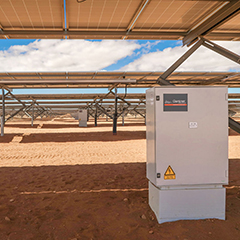After successful on schedule commissioning of the 64.1MW Egyptian Benban solar power plant in December 2017, Gantner Instruments Environment Solutions is pleased to announce that the company was repeatly chosen as supplier for the complete monitoring system for the next three plants in Benban complex with a total of 166.5MW.
Gantners monitoring and control solution “Made in Germany” is an optimised, individually tailored system and – as result of high quality engineering – based on newest technology.
Project scope and components provided by Gantner:
Q.reader data logger and Power plant controller
The heart of Gantners monitoring solution is the inverter independent datalogger Q.reader which tracks and controls all power plant information. The scalable modular design allows to control up to 100MW by one Q.reader. As Power plant controller (PPC) it provides all important functionality as absolute production constraint, power gradient constraint, voltage control, power factor control etc. The PPC fulfils the requirements of the Solar Energy Plants Grid Connection Code, in addition to the Egyptian Transmission Grid Code (ETGC). Also grid communication to the Egyptian Electricity Transmission Company (EETC) is in the scope of our solution and based on IEC 60870 standard.
DC Combiner boxes
Gantners latest string level monitoring devices “string.bloxx” provide current measurements 10 times more accurate compared with competing monitoring solutions, not susceptible to temperature variance. Designed as an integral component of our individually customized DC Combiner boxes (DCB) “string.CB/CC” they are applicable for string voltage up to 1500V and dimensioned for up to 32 PV strings. The composition of our highly demanded DCBs has been ten of thousand times successfully proven itself in various solar projects, often with very special requirements in terms of both technical performance and of regional standards as well as in extreme climatic conditions.




























